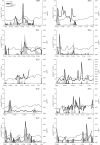Secondary Outcomes of the Ole e 1 Proteins Involved in Pollen Tube Development: Impact on Allergies
- PMID: 32719701
- PMCID: PMC7349006
- DOI: 10.3389/fpls.2020.00974
Secondary Outcomes of the Ole e 1 Proteins Involved in Pollen Tube Development: Impact on Allergies
Abstract
Ole e 1 protein is involved in olive fertilization mechanisms controlling pollen tube development. Similarly to the process by which pollen grains hydrated and form a pollen tube upon arrival at the female gametophyte, when pollen grains fall on the nasal mucosa the expression of Ole e 1 protein induce allergic reaction in sensitive individuals. The research was conducted in Ourense (North-western Spain), during the 2009-2018 period. Ole e 1 protein was collected using a Cyclone Sampler and processed with the ELISA methodology. Airborne Olea pollen were monitored using a Hirst type volumetric sampler. Allergy risk episodes identified by pollen concentrations were detected in five of the 10 studied years, all with moderate risk. Actual risk episodes of allergy increased when the combination of pollen and Ole e 1 concentrations were considered. Moderate risk episodes were detected during 9 years and high-risk episodes during 3 years. In addition, some years of low annual pollen concentrations recorded high total amounts of Ole e 1. During the years with lower pollen production, the tree increases the synthesis of Ole e 1 to ensure proper pollen tube elongation in order to complete a successful fertilization. This fact could justify higher sensitization rates in years in which a lower pollen production is expected. The present method contributes to the determination of the real exposure to Ole e 1 allergen evaluating the role of this protein as an aeroallergen for sensitized population. The allergen content in the atmosphere should be considered to enhance the prevention of pollinosis clinical symptomatology and the reduction of medicine consumption.
Keywords: ELISA; Ole e 1; aeroallergens; allergy risk days; pollen.
Copyright © 2020 Fernández-González, González-Fernández, Fernández-González and Rodríguez-Rajo.
Figures
References
-
- Aguilera F., Fornaciari M., Ruiz-Valenzuela L., Galán C., Msallem M., Ben Dhiab A., et al. (2015). Phenological models to predict the main flowering phases of olive (Olea europaea L.) along a latitudinal and longitudinal gradient across the Mediterranean región. Int. J. Biometeorol. 59, 629–641. 10.1007/s00484-014-0876-7 - DOI - PubMed
-
- Alché J. D., Castro A. J., Olmedilla A., Fernández M. C., Rodríguez R., Villalba M., et al. (1999). The major olive pollen aller-gen (Ole e I) shows both gametophytic and sporophytic expression during anther development, and its synthesis and storage takes place in the RER. J. Cell Sci. 112, 2501–2509. - PubMed
-
- Alché J. D., M’rani-Alaoui M., Castro A. J., Rodríguez-García M. I. (2004). Ole e 1, the major allergen from olive (Olea europaea L.) pollen, increases its expression and is released to the culture medium during in vitro germination. Plant Cell Physiol. 45, 1149–1157. 10.1093/pcp/pch127 - DOI - PubMed
LinkOut - more resources
Full Text Sources


